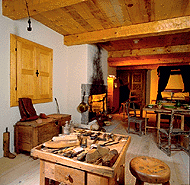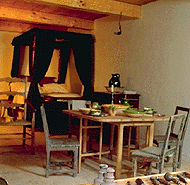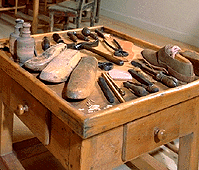Canada Hall
 The Shoemaker's
House
The Shoemaker's
House
It was not uncommon for merchants, retailers, and small-scale entrepreneurs to live and work in the same house. The house of the shoemaker, or cordwainer, is similar to that of other urban artisans of the period. Since he was usually not wealthy enough to own a house, the cordwainer rented the first floor, and the second floor was occupied by another tenant. In rather cramped quarters, therefore, the cordwainer housed and fed his family, and made and repaired shoes and leather goods.
 |
 |
 |
 |
The cordwainer worked either alone or with an apprentice, taking orders for custom-made shoes that were crafted entirely by hand. The nineteenth-century shoemaker's tools in the collections of the Canadian Museum of Civilization are very similar to those used by shoemakers a hundred years earlier.
In the eighteenth century, the cordwainer's principal products were French-style shoes. When clients ordered a pair of shoes, the cordwainer would first measure their feet by using a size-stick. He would then choose the lasts and the appropriate patterns (for regular clients, these were usually prepared in advance).



